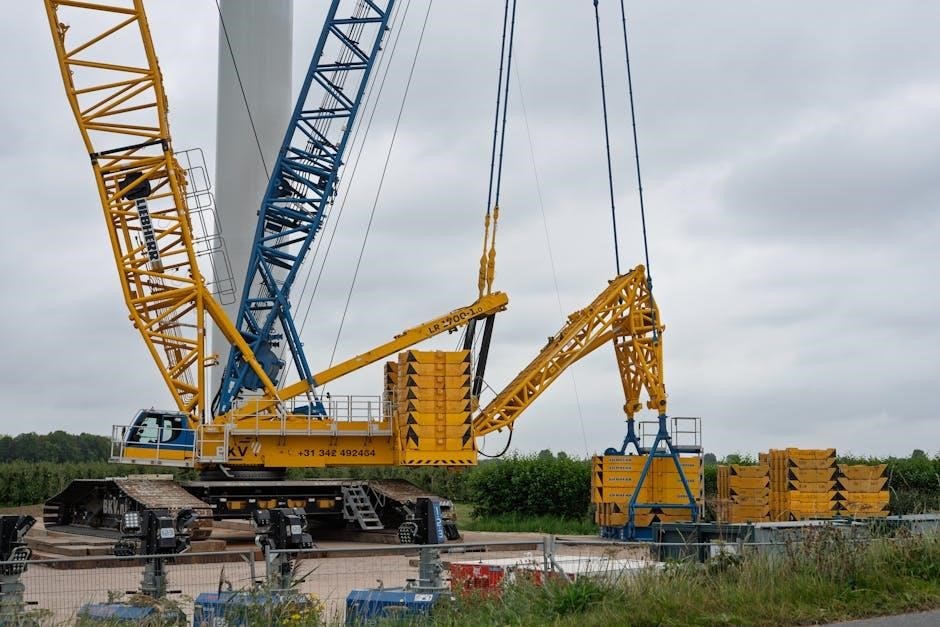Proper lifting techniques are essential for preventing injuries and ensuring workplace safety․ They involve understanding ergonomics, assessing loads, and using correct body mechanics to minimize strain․

Importance of Safe Lifting Practices
Safe lifting practices are crucial for preventing injuries and promoting workplace safety․ Back injuries, often caused by improper lifting, account for one in five workplace injuries and result in significant medical costs and lost productivity․ According to the Bureau of Labor Statistics, over one million workers experience back injuries annually, with low back pain being a leading reason for missed work․ Implementing safe lifting practices reduces the risk of musculoskeletal disorders and creates a safer work environment․ Ergonomic techniques and proper lifting methods minimize strain on the body, while training programs ensure employees adopt these practices consistently․ Prioritizing safe lifting not only protects workers’ health but also reduces workers’ compensation claims and enhances overall workplace efficiency․
Overview of Common Lifting-Related Injuries
Lifting-related injuries often involve the lower back, shoulders, and knees․ Strains and sprains are the most common, occurring when muscles or ligaments are overextended․ Herniated discs and musculoskeletal disorders frequently result from improper lifting techniques․ According to the Bureau of Labor Statistics, back injuries alone account for over one million cases annually, with many requiring medical attention and time off work․ Repetitive lifting can lead to chronic pain and long-term damage․ Poor posture, twisting, and lifting heavy loads without assistance exacerbate these risks․ Understanding these injuries highlights the need for proper training and ergonomic practices to minimize their occurrence and protect worker health․
Benefits of Implementing Proper Lifting Techniques
Implementing proper lifting techniques significantly reduces the risk of workplace injuries, particularly back strains and musculoskeletal disorders․ This leads to lower medical costs, fewer lost workdays, and increased productivity․ Employers benefit from reduced workers’ compensation claims and improved employee morale․ Proper lifting practices also enhance overall workplace safety, creating a culture of prevention and well-being․ Additionally, these techniques promote long-term health for workers, reducing the likelihood of chronic pain and disabilities․ By prioritizing safe lifting, organizations can comply with ergonomic standards and foster a safer, more efficient work environment․ Ultimately, proper lifting techniques are a simple yet effective way to protect both employees and businesses․
Understanding Lifting Ergonomics
Lifting ergonomics focuses on optimizing tasks to reduce physical strain․ Key principles include limiting load weight, minimizing repetitive lifting, and avoiding awkward postures to enhance worker well-being and safety․
Key Principles of Ergonomic Lifting
The key principles of ergonomic lifting emphasize reducing physical strain by aligning tasks with human capabilities․ Central to this is maintaining a neutral spine position, avoiding unnecessary twisting, and ensuring loads are within a manageable weight range․ Proper foot placement and stance are crucial, allowing for balance and stability․ Distributing the weight evenly and using leg muscles rather than the back to lift minimizes injury risk․ Additionally, the workplace should be organized to minimize reaching and bending, and regular breaks should be taken during repetitive tasks․ Ergonomic lifting also encourages the use of assistive devices when manual lifting is unavoidable․
How to Assess the Weight and Size of the Load
Assessing the weight and size of a load is critical to ensure safe lifting․ Start by visually estimating the load’s weight and dimensions․ If possible, test the load by tilting or partially lifting it to gauge its heaviness․ Check for uneven distribution of weight, as this can make the load harder to handle․ Measure the load’s height and width to determine if it fits within your lifting range and workspace․ If the load exceeds your lifting capacity or is too bulky, consider seeking assistance or using lifting aids․ Proper assessment helps prevent overexertion and ensures the load can be moved safely and efficiently․
Optimizing Workspace for Safe Lifting
Creating a well-organized workspace is vital for safe lifting practices․ Ensure the area is clear of obstacles to provide an unobstructed path for lifting and moving loads․ Position frequently lifted items at waist height to minimize bending or reaching․ Use storage solutions that keep objects between shoulder and mid-thigh height to reduce strain․ Proper lighting is essential to avoid accidents caused by poor visibility․ Additionally, ensure that the floor is level and non-slip to prevent tripping or losing balance while lifting․ An optimized workspace not only enhances safety but also improves efficiency and reduces the risk of musculoskeletal injuries associated with improper lifting techniques․ Regularly inspect and adjust the workspace to maintain these conditions․
Pre-Lift Preparation
Pre-lift preparation involves planning and assessing the task to ensure safety․ Evaluate the load’s weight, size, and balance, and determine if assistance or equipment is needed․ Always check the path for obstructions and wear appropriate gear to prevent injuries․ Proper preparation minimizes risks and ensures a smooth lifting process․
Planning the Lift: Steps to Take Before Lifting
Planning the lift is crucial for safety and efficiency․ Start by assessing the load’s weight, size, and balance to determine if it requires special handling․ Check for any obstructions in the path and ensure the destination is clear․ Decide whether manual lifting is feasible or if lifting aids like dollies or hoists are needed․ If teamwork is required, assign roles and communicate clearly․ Finally, visualize the lift to anticipate potential challenges and adjust your approach accordingly․ Proper planning minimizes risks and ensures a smooth, incident-free lifting process․ Always prioritize safety over speed․
Using Lifting Aids and Equipment
Using lifting aids and equipment is a critical component of safe lifting practices․ Tools like dollies, hoists, and mechanical arms can significantly reduce physical strain and prevent injuries․ Always assess the load’s weight and size to determine the most appropriate aid for the task․ Ensure the equipment is in good condition and suitable for the load’s weight and shape․ Regularly inspect lifting aids for damage or wear, and follow the manufacturer’s guidelines for use․ Training on proper equipment operation is essential to maximize safety and efficiency․ By incorporating lifting aids, workers can minimize manual effort, lower injury risks, and maintain productivity․ Properly used equipment is a cornerstone of ergonomic lifting․
Wearing proper clothing and safety gear is vital for safe lifting․ Choose clothing that allows a full range of motion without getting caught in equipment․ Avoid loose outfits that may obstruct visibility or movement․ Steel-toed shoes or work boots with good traction are essential to prevent foot injuries and slips․ Gloves can provide a secure grip, reducing the risk of dropping objects․ Additionally, wear a back support belt if recommended by your employer or healthcare professional․ Ensure all gear fits properly and is in good condition․ Wearing appropriate attire and safety gear minimizes hazards, protects against potential injuries, and enhances overall lifting safety․ Proper gear is a key element of safe lifting practices․ The lifting process involves a series of coordinated steps to ensure safety and efficiency․ It begins with proper planning and ends with secure placement of the load․ A proper lifting technique involves several key steps to ensure safety and efficiency․ First, plan the lift by assessing the load’s weight, size, and balance․ Stand with a wide stance and face the object directly․ Bend at the knees, keeping your back straight and core engaged․ Grip the object firmly, holding it close to your body․ Lift by straightening your legs, avoiding any twisting or jerking motions․ Keep the load at wrist height and maintain control throughout the movement․ Finally, place the object down carefully, bending at the knees again to avoid strain․ Proper technique reduces the risk of injury and ensures a safe lifting process․ Proper lifting techniques emphasize the importance of bending at the knees rather than the waist․ Bending at the knees allows you to maintain a straight back, engaging your leg muscles to lift, which reduces strain on the spine․ On the other hand, bending at the waist rounds the back, placing unnecessary pressure on the spinal discs and increasing the risk of injury․ To lift safely, face the object, stand with a wide stance, bend at the knees, and keep the load close to your body․ This technique ensures the weight is lifted by your leg muscles, not your back, minimizing the risk of harm․ Always prioritize bending at the knees for a safer lift․ Engaging your core muscles is a critical component of proper lifting techniques․ A strong, stable core provides essential support to the spine during lifting, reducing the risk of injury․ Before lifting, take a deep breath and tighten your abdominal muscles to brace your core․ This creates a natural girdle of support around your torso․ Throughout the lift, maintain this engagement to ensure stability․ Avoid arching your back or using momentum, as these actions can destabilize the core and transfer unnecessary strain to the spine․ Proper core engagement, combined with bending at the knees, ensures a safer and more controlled lifting process․ This practice helps distribute the weight evenly and protects the back from potential harm․ Placing the load safely and maintaining balance․ Stretching after lifting prevents strain and promotes recovery․ Placing the load safely is crucial to prevent accidents and injuries․ Always ensure the surface is stable and clear of obstacles․ Maintain a firm grip on the object until it is securely positioned․ Avoid placing heavy loads above shoulder height or in hard-to-reach areas․ Use lifting aids or equipment when necessary to stabilize the load․ Check the surroundings to ensure no one is in the path of the object․ If the load is unbalanced or uneven, seek assistance or use mechanical aids․ Proper placement prevents slips, trips, and potential damage to the object or nearby equipment․ Prioritize stability and control when setting down the load to maintain a safe environment․ Stretching after lifting is a critical step to prevent muscle strain and promote recovery․ Focus on stretching the major muscle groups used during the lift, such as the hamstrings, quadriceps, and lower back․ Hold each stretch for 20-30 seconds to allow muscles to relax and lengthen․ Avoid bouncing or forcing the stretch, as this can cause further strain․ Incorporate deep breathing to enhance relaxation and reduce tension․ Regular post-lift stretching can improve flexibility, reduce soreness, and lower the risk of injury․ Consistency is key; make stretching a routine part of your lifting process․ Additionally, consider consulting a fitness professional to develop a personalized stretching routine tailored to your lifting activities․ Overestimating one’s lifting capacity, twisting while lifting, and lifting without a clear path are common errors that increase injury risks and should be strictly avoided․ Overestimating one’s lifting capacity is a frequent mistake that can lead to severe injuries․ Many workers believe they can handle heavier loads than they actually can, often resulting in strained muscles or spinal damage․ It is crucial to recognize personal physical limits and assess the weight of the object before lifting․ Ergonomic guidelines suggest that loads exceeding a certain threshold should not be lifted manually․ Ignoring these recommendations increases the risk of musculoskeletal disorders․ Employers should encourage workers to prioritize safety over task completion․ Using lifting aids or seeking assistance when unsure is always the best practice to avoid preventable injuries․ Twisting or turning while lifting is a dangerous practice that significantly increases the risk of injury, particularly to the spine and muscles․ This motion puts uneven strain on the back, leading to potential herniated discs or pulled muscles․ Proper lifting techniques emphasize maintaining a stable posture and facing the load directly․ Instead of twisting, workers should pivot their feet or reposition themselves to maintain a straight path for lifting․ Twisting also reduces control over the load, making it harder to handle safely․ Employers should train employees to avoid this common mistake by planning lifts in advance and using appropriate ergonomics to minimize the need for unsafe movements․ Always prioritize stability and control during lifting tasks to protect against preventable injuries․ Lifting without a clear path is a common mistake that can lead to accidents and injuries․ A cluttered or obstructed workspace forces individuals to maneuver awkwardly, increasing the risk of tripping or losing control of the load․ Proper lifting techniques stress the importance of ensuring a safe, unobstructed path before lifting․ This includes clearing the area of obstacles and planning the route in advance․ Without a clear path, workers may need to twist or stretch, which can strain muscles and compromise lifting safety․ Employers should emphasize the need for a clean workspace and proper planning to prevent such hazards․ A clear path ensures smooth, controlled movements, reducing the likelihood of accidents and related injuries․ Always assess the environment before initiating a lift to maintain safety․ Proper lifting techniques are best learned through structured training programs, emphasizing safe practices and injury prevention․ Education is key to fostering a culture of lifting safety; Workplace training programs on proper lifting techniques are crucial for reducing injuries and enhancing employee safety․ According to the Bureau of Labor Statistics, back injuries account for a significant portion of workplace incidents, with many resulting from improper lifting․ These programs educate employees on ergonomic principles, load assessment, and correct lifting methods․ By incorporating practical demonstrations and real-life scenarios, training ensures that workers can apply safe practices consistently․ Regular refreshers and updates also keep safety protocols top of mind, fostering a culture of prevention and responsibility․ Investing in such programs not only protects employees but also reduces costs associated with workers’ compensation claims and lost productivity․ There are numerous resources available to learn proper lifting techniques, ensuring a safe and injury-free experience․ The Occupational Safety and Health Administration (OSHA) provides comprehensive guides and training materials that outline ergonomic principles and safe lifting practices․ Additionally, the National Institute for Occupational Safety and Health (NIOSH) offers detailed lifting equations and guidelines to assess and manage workplace lifting tasks․ Online courses, such as those offered by OSHA․com, provide interactive training sessions and certifications․ Employers can also utilize toolbox talks and safety manuals to educate employees․ These resources emphasize the importance of proper lifting techniques and offer practical strategies to implement them effectively in various work environments․ Specialized lifting techniques are essential for handling unique scenarios, such as lifting in tight spaces or managing awkward loads․ These methods ensure safety and efficiency in challenging situations․ Lifting in tight or confined spaces requires specialized techniques to ensure safety and efficiency․ These situations often involve limited mobility, making proper body positioning and load control critical․ Start by planning the lift, ensuring a clear path and adequate space to maneuver․ Use ergonomic lifting aids, such as hoists or dollies, to reduce manual strain․ Maintain a stable stance with feet shoulder-width apart and keep the load close to your body․ Avoid twisting or bending, as these movements increase injury risk․ If possible, enlist a second person to assist with coordination and balance․ Always prioritize slow, controlled movements to prevent accidents in confined environments․ Lifting awkward or unbalanced loads poses unique challenges, requiring extra caution to prevent injuries and maintain control․ Assess the load’s weight distribution and shape beforehand to determine the best lifting approach․ Use ergonomic equipment like harnesses or grips to secure the load and improve stability․ Position your body to face the load, keeping it close to your center of gravity․ Bend at the knees, engage your core, and lift with leg strength rather than your back․ Avoid sudden movements or jerks, as they can cause loss of balance or strain․ If the load is too heavy or unstable, consider enlisting assistance or using mechanical aids to ensure a safe and controlled lift․ Always prioritize stability and control when handling such loads․ Proper lifting techniques are vital for reducing injuries and enhancing workplace safety․ By adopting these practices, individuals can protect their health and maintain long-term well-being effectively․ Proper lifting techniques are crucial for preventing injuries and ensuring workplace safety․ Key principles include bending at the knees, maintaining a straight back, and using ergonomic practices․ Always assess the load’s weight and size before lifting, and consider using lifting aids when necessary․ Keeping the object close to your body and avoiding twists minimizes strain․ Training and education play a vital role in promoting safe lifting habits․ Regular stretching and post-lift care can further reduce the risk of muscle strain․ By adhering to these guidelines, individuals can protect their health and contribute to a safer work environment․ Consistent practice of these techniques ensures long-term well-being and productivity․ Fostering a culture of lifting safety requires ongoing education, open communication, and leadership commitment․ Employers should prioritize training programs that emphasize proper techniques and ergonomic practices․ Encouraging employees to report unsafe conditions and near misses creates a supportive environment․ Recognizing and rewarding safe lifting practices motivates staff to maintain these habits․ Regular updates on injury trends and prevention strategies keep safety top of mind․ Engaging employees in safety discussions ensures collective responsibility․ By integrating lifting safety into daily routines, organizations can reduce injuries, enhance productivity, and promote a culture where safety is everyone’s priority․ This proactive approach benefits both employees and employers, creating a healthier workplace․ Access OSHA guidelines and ergonomic lifting guides for comprehensive training materials and workplace safety strategies to prevent injuries․ For in-depth learning, explore OSHA’s guidelines and ergonomic lifting guides․ The “Proper Lifting Techniques” manual by J․ Gaarder provides practical insights, while Harvard’s Toolbox Talk offers evidence-based strategies․ These resources emphasize safe practices, injury prevention, and optimal lifting methods․ They are ideal for both workplace training and personal use, ensuring a comprehensive understanding of lifting safety․ Online courses are an excellent way to master proper lifting techniques․ OSHA offers comprehensive training programs that cover ergonomic principles and safe lifting practices․ Websites like Safety․com and EHS provide interactive modules with video demonstrations and quizzes․ These courses emphasize injury prevention, load assessment, and correct body mechanics․ Many programs are designed for both employees and employers, ensuring a workplace culture of safety․ They often include certifications upon completion, making them ideal for compliance and skill development․ By enrolling in these courses, individuals can gain practical knowledge and reduce the risk of lifting-related injuries․ They are accessible, affordable, and tailored to various industries․Wearing Proper Clothing and Safety Gear

The Lifting Process
Step-by-Step Guide to Proper Lifting Technique

Bending at the Knees vs․ Bending at the Waist

Engaging Core Muscles During the Lift
Post-Lift Actions
Placing the Load Safely
Stretching After Lifting to Prevent Strain

Common Mistakes to Avoid

Overestimating One’s Lifting Capacity
Twisting or Turning While Lifting
Lifting Without a Clear Path
Training and Education
Importance of Workplace Training Programs
Resources for Learning Proper Lifting Techniques

Specialized Lifting Techniques
Lifting in Tight or Confined Spaces
Lifting Awkward or Unbalanced Loads

Encouraging a Culture of Lifting Safety

Additional Resources
Recommended Reading and Guides
Online Courses for Proper Lifting Techniques
